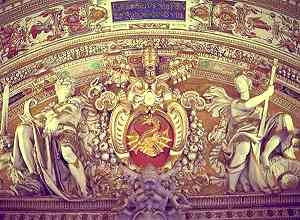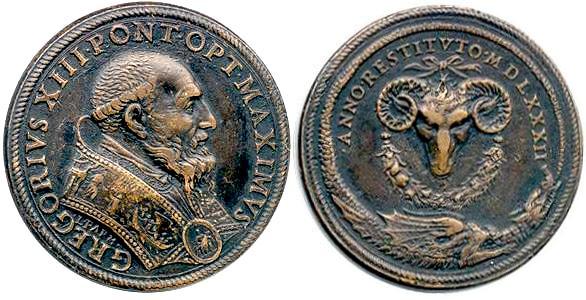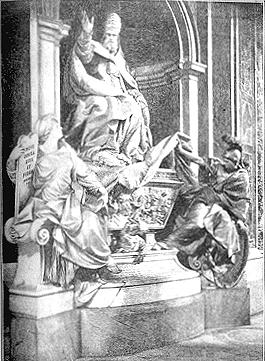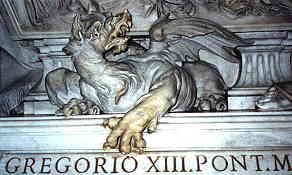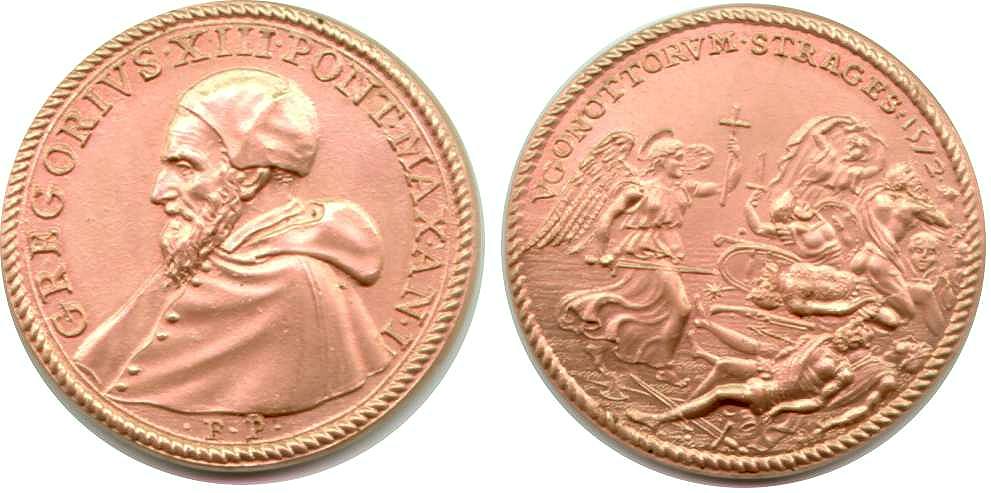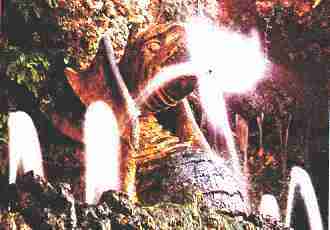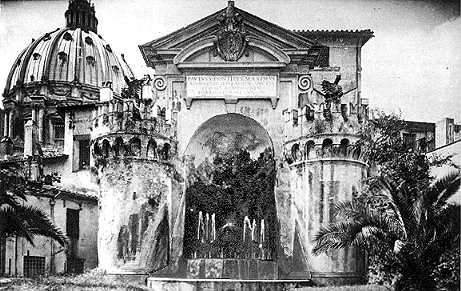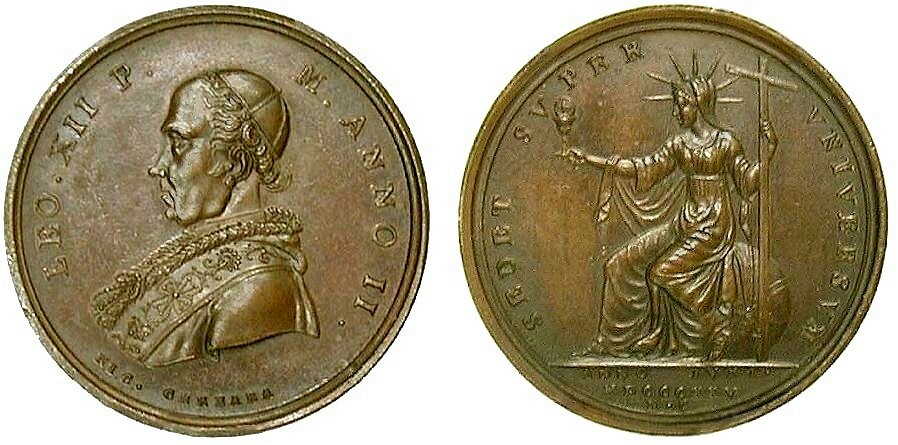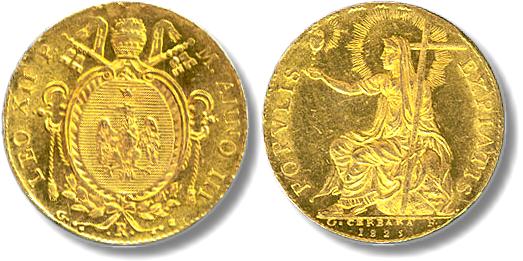 See Empires Diagram
See Empires Diagram
Rev 12:3 And there appeared another wonder in heaven; and behold a great
red dragon, having seven heads and ten horns, and seven crowns upon his
heads.
Rev 12:4 And his tail drew the third part of the stars of heaven, and did
cast them to the earth: and the dragon stood before the woman which was
ready to be delivered, for to devour her child as soon as it was born.
Rev 12:9 And the great dragon was cast out, that old serpent, called the
Devil, and Satan, which deceiveth the whole world: he was cast out into the
earth, and his angels were cast out with him.
The above verses make clear, in even superficial reading, that the Great
Red Dragon is Satan. But there is another relationship that is not as readily
apparent. Verse 4 is referring to the birth of Jesus, and Satan's attempt to
kill the infant Jesus. Satan however, did not attempt this act of murder on
his own. He made his attempt through the power of one man on earth. This man
is identified:
Mat 2:13 And when they were departed, behold, the angel of the Lord
appeareth to Joseph in a dream, saying, Arise, and take the young child and
his mother, and flee into Egypt, and be thou there until I bring thee word:
for Herod will seek the young child to destroy him.
Herod the Great, the King of Judea and Palestine was the agent Satan used
in his attempt to kill the infant Jesus. It is significant to note that Herod
received his office from the Roman Empire. In 37 B.C. Herod the Great
conquered Jerusalem with the aid of Roman armies and made himself king.
Now notice again in Rev 12:3 that Satan is described as having seven heads,
ten horns and seven crowns. This is important because it is a key to identify
Satan and his agents elsewhere in Revelation:
Rev 13:1 And I stood upon the sand of the sea, and saw a beast rise up
out of the sea, having seven heads and ten horns, and upon his horns ten
crowns, and upon his heads the name of blasphemy.
Rev 13:2 And the beast which I saw was like unto a leopard, and his feet
were as the feet of a bear, and his mouth as the mouth of a lion: and the
dragon gave him his power, and his seat, and great authority.
Here another agent of Satan can be found. Although nearly identical in
description, it is not Satan, because verse 2 says this beast power gets his
power from the dragon - a clear reference to Satan. As we observed in Matthew,
Satan used the power of the ancient Roman Empire to attempt the murder of
Jesus. The dragon and Rome worked with the same mind toward the same goal. So
in Rev 13:2 we can possibly substitute Rome for the word Dragon. Lets explore
a little farther.
Note the animals that are mentioned. This is a reference back to Daniel 7.
John the Revelator was looking backwards in sequence at the previous empires,
to give us a time hack if you will, to identify this Sea Beast in the stream
of time. The Lion (Babylon) is referred to as the head of Gold in Dan 2, the
Bear (Medo-Persia) which is also the chest of silver in Dan 2, and the Leopard
(Greece) the thighs of brass in Dan 2. Now there is also a fourth beast in Dan
7, to match the legs of iron in Dan 2 -
Dan 7:7 After this I saw in the night visions, and behold a fourth beast,
dreadful and terrible, and strong exceedingly; and it had great iron teeth:
it devoured and brake in pieces, and stamped the residue with the feet of
it: and it was diverse from all the beasts that were before it; and it had
TEN HORNS.
This fourth diverse beast with ten horns correlates to ancient pagan Rome.
Ancient pagan Rome, when it disintegrated, was followed by the divided
kingdoms, which is to say a divided Europe (a condition that exists today),
represented by the feet and TEN TOES of clay and iron in Dan 2.

The Winged Dragon and Rome
In 312 A.D. Emperor Constantine was about to enter into battle with his
rival emperor Maxentius. Greatly outnumbered by his opponents army,
Constantine on the day before the impending battle saw a vision in the sky of
a cross with the words "In Hoc Signo Crucis Vinces" emblazoned about it, which
means "In This Sign (the Cross) You Shall Conquer". Constantine immediately
adopted the cross as his emblem and had it put on troops and banners. The
following day Constantine defeated Maxentius in the battle of Milvian Bridge.
Constantine went on to declare Christianity the state religion of Rome and was
himself later baptized a Christian.
A fresco in the Vatican, (The Sala di Constantino, Palazzi Vaticani, Rome)
painted by RAFFAELLO (1509-10 A.D.) depicts  Emperor Constantine's Vision of the Cross.
Emperor Constantine's Vision of the Cross.

In the fresco, note what is in the upper right-hand corner (and shown
above). There you will see a winged serpent, or dragon. Raffaello was
depicting a pivotal moment in the conversion of Pagan Rome to Christianity,
the dragon he painted being symbolic of ancient Pagan Rome.

The Transfer of Power to the Bishop of Rome.
As we established with Rev 12:4, the dragon's agent in trying
to kill Christ was ancient Rome (through Herod). With this relationship of
Dragon = Rome we can see that the beast from the sea of Revelation 13 should
get his power and seat and great authority from the Ancient Roman Empire,
through Satan, just like Herod did. This prompts the question, did ancient
Rome formally bestow its power and authority on any existing power?
A check of history will reveal the successor to the Roman
emperors. With the move of the Roman capitol to Constantinople, there was a
political power vacuum that was quickly and willingly filled by the Bishop of
Rome-
[p. 269] Whatever Roman elements the barbarians and Arians
left … [came] under the protection of the Bishop of Rome, who was the chief
person there after the Emperor’s disappearance… [p. 270] The Roman Church in
this way privily pushed itself into the place of the Roman World-Empire, of
which it is the actual continuation; the empire has not perished, but has
only undergone a transformation … That is no mere “clever remark,” but the
recognition of the true state of the matter historically, and the most
appropriate and fruitful way of describing the character of this Church. It
still governs the nations … It is a political creation, and as imposing as a
World-Empire, because the continuation of the Roman Empire. The Pope, who
calls himself “King” and “Pontifex Maximus,” is Caesar’s successor.
Source: Adolf Harnack, What Is Christianity? trans.
by Thomas Bailey Saunders (2d ed., rev.; New York: Putnam, 1901), pp. 269,
270. [Ernest Benn Ltd., London, has recently published a new edition of this
book.]

The archetype from which the pope descends is that of the imperial Caesar,
... while for the most part Italy wasn't even a unified state - unlike France,
Spain, England, Russia - that unique supreme Christian authority, purely
Italian, nevertheless continued to represent the universality descended from
the emperors. It is not paradoxical to say that in Italy the monarchy has
continued to exist despite the expulsion of the royal House of Savoy, because
the monarchical authority of the pontiff has a charisma and a national power
of attraction that no president of the republic has ever been able to claim.
Source: Why the next pope needs to be Italian,
by Roberto Pazzi, The International Herald Tribune Online, Monday, January
12, 2004, translated by Ann McGarrell from Italian.

One of the most famous forged documents ever was the Donation
of Constantine, which it was claimed, proved that Emperor Constantine had
given authority and property to the Pontiff of Rome. For many centuries the
Donation of Constantine was used by the Catholic church to validate it's claim
to authority. OK, you say, but that was a forgery - it was not an authentic
transfer of power to the Papacy. True. There was such a document however, the
authenticity of which is not challenged even to this day. In 533 A.D. Roman
Emperor Justinian in the  Justinian Code declared the Bishop of Rome to have the first rank of
all pontiffs, head of all Christian churches, and that he (Justinian) would
exert every effort to increase the honor and authority of the Apostolic See of
Rome! This was the formal transfer of power from the Emperor of Pagan Rome to
the Papacy. It should be noted however, the implementation of this decree did
not actually occur until 538 A.D. when a siege of Rome by the Ostrogoths was
broken.
Justinian Code declared the Bishop of Rome to have the first rank of
all pontiffs, head of all Christian churches, and that he (Justinian) would
exert every effort to increase the honor and authority of the Apostolic See of
Rome! This was the formal transfer of power from the Emperor of Pagan Rome to
the Papacy. It should be noted however, the implementation of this decree did
not actually occur until 538 A.D. when a siege of Rome by the Ostrogoths was
broken.
Dan 7:7 After this I saw in the night visions, and behold a
fourth beast, dreadful and terrible, and strong exceedingly; and it had
great iron teeth: it devoured and brake in pieces, and stamped the residue
with the feet of it: and it was diverse from all the beasts that were before
it; and it had ten horns.
Rome is described in Dan 7:7 as diverse, or different from
previous powers. This is because, as we have seen, the ancient Pagan Roman
empire GAVE political power and religious authority to it's successor, the
Roman Catholic Church.
Note that each of the beasts in Daniel can be described as
UNIVERSAL powers that dominated the world at the time. Ancient Rome also was a
universal power, yet in time, the Roman empire faded. It's clear successor is
the UNIVERSAL (Catholic) CHURCH - again another universal power. Rome was the
diverse fourth power because it evolved from a Pagan Political power, into a
Christian religious AND political power, though still dominated by Pagan
beliefs.
The "Little Horn" Power
Dan 7:8 I considered the (10) horns, and, behold, there came
up among them another little horn, ...
Pope Pius IX gave this remarkable testimony:
"It is, therefore, by a particular decree of Divine Providence
that, at the fall of the Roman Empire and its partition into separate
kingdoms, the Roman Pontiff, whom Christ made the head and center of his
entire Church, acquired civil power." − Pius IX,
Apostolic Letter
 Cum Catholica Ecclesia, March 26,
1860.
Cum Catholica Ecclesia, March 26,
1860.
Source: Papal
Teachings: The Church, selected and arranged by the Benedictine Monks of Solesmes,
translated by Mother E. O'Gorman, R.S.C.J., Manhattanville College of the
Sacred Heart, St. Paul Editions, Boston, © 1980, 1962 by Daughters of St.
Paul, Library of Congress catalog card number 62-12454, par. #225,
 page 160.
page 160.
Divine Providence indeed! Daniel
had prophesied it! The phrase "little horn" indicates a "little kingdom". This is
one of the distinguishing characteristics of this entity, its small size
geographically. The Vatican, the headquarters for the Catholic Church located
in Rome, is today the smallest independent country in the world, covering
only about 108 acres in size. The papal monarchy came up among the divided kingdoms (the 10
horns), after the fall of the Rome Empire, and has had influence greatly disproportionate to its
geographical size.
Dan 7:8 ... before whom there were three of the first horns
plucked up by the roots: ...
Who were these three kingdoms that were uprooted? The Heruli,
Vandals, and finally the Ostrogoths. Each of them were Arian, considered
heretics by the Roman Catholic Church, and were defeated by the Emperor on the Pope's
behalf.
Dan 7:8 ... and, behold, in this horn were eyes like the
eyes of man, and a mouth speaking great things.
This now should be an obvious reference to the great things
and blasphemies spoken by a man of the Roman Catholic church (the Papacy),
that persecuted the saints for 1260 years, changed the day of rest and
tampered with the Ten Commandments and also defeated three other European
political powers that followed the downfall of the Roman Empire.
Tampering with God's Unchangeable Law.
Look at Daniel 7:25 -
Dan 7:25 And he shall speak great words against the most
High,
and shall wear out the saints of the most High,
and think to change times and laws (of the most High):
and they shall be given into his hand until a time and times and the
dividing of time.
Note what I added in parenthesis above. The Little Horn (The
Papacy) thinks to be able to change times and laws, and in context it is
speaking about the times and laws of God. So has the Papacy, the Roman
Catholic Church, claimed that the Law of of God, the Ten Commandments can be
changed? Indeed they do. They think they have done it by changing the day of
rest to Sunday! In one action they have fulfilled that portion of the prophecy
of Daniel 7:25, changing both the time and the law of God.
Here is a link to the Catholic New Advent web page. Note what
they say about the  Sabbath commandment
(3rd by Catholic reckoning)-
Sabbath commandment
(3rd by Catholic reckoning)-
Here is a link to the  Catholic Baltimore Catechism on the Sabbath commandment. Read #353 to
#360...
Catholic Baltimore Catechism on the Sabbath commandment. Read #353 to
#360...
Here is the  General
index to the Baltimore Catechism.
General
index to the Baltimore Catechism.
Note the fate of this beast in Daniel:
Dan 7:11 I beheld then because of the voice of the great
words which the horn spake: I beheld even till the beast was slain, and his
body destroyed, and given to the burning flame.
This is also a reference to:
Rev 19:20 And the beast was taken, and with him the false
prophet that wrought miracles before him, with which he deceived them that
had received the mark of the beast, and them that worshipped his image.
These both were cast alive into a lake of fire burning with brimstone.
Continuing to follow the trail of seven heads and ten horns in
the Bible leads us also to a beast in Rev 17, the same beast destroyed in Rev
19:20 as we have just seen.
Rev 17:3 So he carried me away in the
spirit into the wilderness: and I saw a woman sit upon a scarlet coloured
beast, full of names of blasphemy, having seven heads and ten horns.
Rev 17:4 And the woman was arrayed in purple and scarlet colour, and decked
with gold and precious stones and pearls, having a golden cup in her hand
full of abominations and filthiness of her fornication:
Rev 17:5 And upon her forehead was a name written, MYSTERY, BABYLON THE
GREAT, THE MOTHER OF HARLOTS AND ABOMINATIONS OF THE EARTH.
Rev 17:6 And I saw the woman drunken with the blood of the saints, and with
the blood of the martyrs of Jesus: and when I saw her, I wondered with great
admiration.
Note the contrast of this woman with the woman found in Rev
12. In scripture a woman commonly represents a church (Jer 6:2, Isa 54:5-6,
Hos 2:19-20, John 3:29, 2 Cor 11:2, Rev 19:7-8). The symbolic woman of Rev 12
represents the righteous church of believers that brought forth Jesus and is
described in admirable terms. Compare that with the symbolic woman described
here in Rev 17, the apostate church. Note that this church is described as the
Mother of Harlots. There is only ONE Christian church that is self-described
as the Mother church - the Roman Catholic Church - and her Protestant
daughters are called harlots.

The Mother Church
St. John Lateran Cathedral
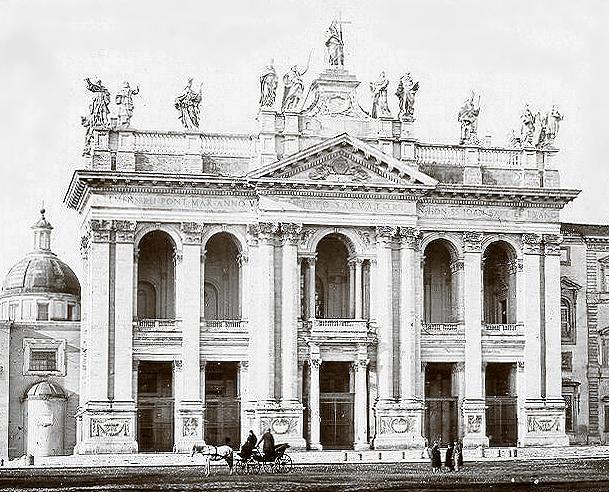

© 1999-2004 by Gregory Ferdinandsen
Above is the inscription at the base of the columns on either side
of the central entrance door of St. John Lateran, the Cathedral of the
Bishop of Rome, the pope. It reads:
SACROS LATERAN ECCLES
OMNIUM URBIS ET ORBIS
ECCLESIARUM MATER
ET CAPUT.
It translates to "Sacred Lateran Church, Universally for
the City and the World, Supreme Mother of Churches", a fulfillment of
Revelation 17:5.
Rev 17:5 And upon her forehead was a name written, MYSTERY, BABYLON THE GREAT,
THE MOTHER OF HARLOTS AND ABOMINATIONS OF THE EARTH.
Rev 17:18 And the woman which thou sawest is that great
city, which reigneth over the kings of the earth.
Here we are told that the woman of Rev 17, the apostate
church, is the same entity as the great city of Babylon that reigns over the
kings of the earth, found in Rev 18. There is only one church that history
shows to have made the claim of authority over the kings of the earth. That
church is the Roman Catholic Church, and Babylon is the code word for the city
of Rome-
1 Pet 5:13 The church that is at Babylon, elected together
with you, saluteth you; and so doth Marcus my son.
This verse is widely recognized as meaning Rome, not Babylon. Roman Catholics have even acknowledged this association:
"Babylon," from which Peter addresses his first Epistle, is
understood by learned annotators, Protestant and Catholic, to refer to Rome
- the word Babylon being symbolic of the corruption then prevailing in the
city of the Caesars.
Source: Faith of Our Fathers, by James Cardinal
Gibbons, 111th printing, Published by  TAN Books and Publishers, INC.,
P.O. Box 424, Rockford, Illinois 61105, Copyright 1980, page 87.
TAN Books and Publishers, INC.,
P.O. Box 424, Rockford, Illinois 61105, Copyright 1980, page 87.

Here is wisdom
There are two verses in Revelation that have a striking
relationship, both calling for wisdom:
Rev 13:18 Here is wisdom. Let him that hath understanding
count the number of the beast: for it is the number of a man; and his number
is Six hundred threescore and six.
Rev 17:9 And here is the mind which hath wisdom. The seven
heads are seven mountains, on which the woman sitteth.
This is a clear linkage of the number 666 with the woman that
sits on seven mountains. A woman is common symbology in the Bible for a
church. Look in any encyclopedia and you will discover that Rome is the city
of seven hills or mountains. It is very interesting to note that Vatican City
and St. Peter's Basilica of the Catholic Church were built upon what was
called in Latin vaticanus mons or vaticanus collis, which
when translated means "hill of prophecy":
vatis / vatic = prophecy, anus = of
mons / collis = hill or mountain.
Rev 17:18 And the woman which thou sawest is that great
city, which reigneth over the kings of the earth.
|
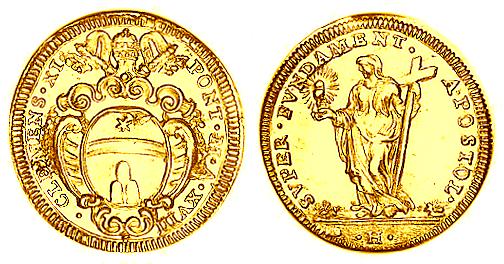 |
|
A gold Scudo minted during the reign of Pope Clement
XI in 1718
(Anno XVIII) with a cup holding Fides on the reverse. (Berman 2363, KM
771) |
The woman of Rev 17, holding a golden cup, is described in
verse 6 as being drunk with the blood of martyrs of Jesus. There is only one
Christian church responsible for the death of thousands and thousands of
fellow Christians during prolonged periods of persecution - the Roman Catholic
Church. This happened in what is called the Dark Ages of European history.
Christians were burned at the stake for possessing a Bible, speaking verses in
the common tongue rather than Latin, or contradicting the policies of the
Papacy. Uncounted thousands were slaughtered during this persecution. Note the
following:
(Rev 13:15) ... And cause that as many as would not
worship the image of the beast should be put to death.
Christ does not do so, neither his Prophets or Apostles
teach so, neither have the kings that are Christians received any such
instructions to kill men, or to make them think that the worship of Christ
is to be stained with blood; for the true God doth not desire any forced,
but voluntary service. Wherefore by his mark especially will he make it
evident to all that have any understanding, that indeed he is the
Antichrist; that indeed he is not Christ, but, according to his name,
opposite and contrary to Christ. He is Christ that sheds his own blood, he
is Antichrist that sheds the blood of others. -- Rupertus, Abbot of Tuits,
in his12th century commentary on Revelation, Apoc. lib. 3. cap. 13.
Source: Pierre Allix, Ecclesiastical History of Ancient
Churches of the Piedmont, published in Oxford at the Clarendon Press in
1821, reprinted in USA in 1989 by Church History Research & Archives, P.O. Box
38, Dayton Ohio, 45449, p. 230
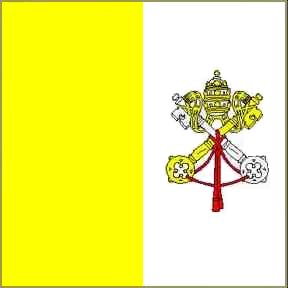 |
The woman of Revelation 17 also rides a beast, and in Bible
prophecy a beast is symbolic of a political power or country. So the
woman / church of Revelation 17 rides on the political power of the
state. The Vatican is not only a city, but since the Lateran Treaty of
1929 signed with Mussolini it is again also a country, with diplomatic
relations with nearly every other nation on earth, and the Pope is the
head of state. On the left is the Vatican state flag.
|
She also bears the name of Mystery. Mystery is the term used
by the Roman Catholic Church to refer to the Mass, specifically the
transubstantiation of the bread and wine into the body and blood of Christ. It
is a key part of Catholic dogma. These are the words of the priest in Latin or
English (emphasis is mine):
HIC EST ENIM CALIX SANGUINIS MEI, NOVI ET AETERNI TESTAMENTI:
MYSTERIUM FIDEI, QUI PRO VOBIS ET PRO MULTIS EFFUNDETUR IN
REMISSIONEM PECCATORUM.
FOR THIS IS THE CHALICE OF MY BLOOD, OF THE NEW AND ETERNAL
TESTAMENT, THE MYSTERY OF FAITH, WHICH FOR YOU AND FOR MANY SHALL BE
SHED UNTO THE REMISSION OF SINS.
 The Latin Mass
online at True Catholic, with an English translation.
The Latin Mass
online at True Catholic, with an English translation.
She is described in Revelation 17:3 as full of names of
blasphemy. How does the Bible define blasphemy? Here is one biblical
definition:
Mark 2:5 When Jesus saw their faith, he said unto the sick
of the palsy, Son, thy sins be forgiven thee.
Mark 2:6 But there were certain of the scribes sitting there, and reasoning
in their hearts,
Mark 2:7 Why doth this man thus speak blasphemies? who can forgive sins but
God only?
Only God has the power to forgive you your sins. Yet the Roman
Catholic Church claims this power for it's priests. In addition, for hundreds
of years the Roman Catholic Church sold what it called indulgences. By
contributing to the church, your sins could be forgiven. Indeed the Vatican
itself was built by funds raised in this manner. Indulgences continue today in
the form of penance. They claim there are works you can do that bear either
partial remittance of sins or plenary (full) remittance of sins. So, with the
blessing of the church, you can forgive your own sins by your own actions. As
Mark 2:3-5 shows, these are examples of the blasphemy described in Rev 17:3.

Conclusions Evident with Additional Facts:
A. The Roman Catholic Church (Papal Rome) is the beast
from the sea of Rev 13, the woman of Rev 17 and the Babylon of Rev 18.
B. The Papacy is the Antichrist of Rev 13, whose number
is 666, and he is the little horn of Daniel 7 and 8. His mark of authority is
Sunday worship (the mark of the beast).
C. The Protestant churches derived from the Catholic
Church are considered harlots. This is because they still adhere to much of
the Catholic inspired false doctrine (like the dead go immediately to heaven
or hell) and bear it's mark of authority (Sunday worship). It can be shown
that U.S. based Protestantism is in fact the False Prophet of Revelation, as
well as the image to the beast, the beast being Catholicism.
D. The power behind the Papacy of the Roman Catholic
Church is none other than Satan. He first attempted to use Rome to kill the
infant Jesus. He also used the Roman empire to try to exterminate the early
Christians. This just forced Christianity underground, even in a literal
sense, yet it still flourished. So Satan changed tactics and infiltrated the
church through Pagan practices and began to persecute those who clung to true
doctrine, by using the church itself as the exterminator. This era of papal
power began in 538 A.D. and ended in 1798 a period of 1260 years. This is the
period referred to as 1260 days, 42 months, and 3 1/2 times in the Bible.
The 1260 years of Papal Supremacy
Catholic writers attest to 12 centuries
of Papal Supremacy and Sovereignty:
[pg. 6]
9. ... In books of all sizes, and from the pulpit of every
church, we have been taught from our infancy, that the "beast, the
man of sin, and the scarlet whore," mentioned in the
Revelations, were names which God himself had given to the Pope;
and we have all been taught to believe of the Catholic Church, that her
worship was "idolatrous," and that her doctrines were "damnable."
10. Now let us put a plain question or two to ourselves, and
to these our readers; and we shall quickly be able to form a
[pg. 7]
just estimate of the modesty, sincerity, and
consistency of these revilers of the Catholic religion:
―they will not, because they cannot, deny, that
this religion was the ONLY CHRISTIAN religion in the world for fifteen
hundred years after the death of Christ. They may say, indeed, that for
the first three hundred years there was no Pope seated at Rome. But,
then, for twelve hundred
years there had
been; and, during that period, all the nations of Europe, and some part of
America, had become Christian, and all acknowledged the Pope as their
head in religious matters; and, in short, there was no other
Christian Church known in the world, nor had any other ever been thought of.
Can we believe, then, that Christ, who died to save sinners, who sent forth
his gospel as the means of their salvation, would have suffered a false
Christian religion, and no other than a false Christian religion,
to be known amongst men all this while? Will these modest assailants
of the faith of their and our ancestors assert to our faces, that, for
twelve hundred years at
least, there were no true Christians in the world? Will they tell us, that
Christ, who promised to be with the teachers of his word to the end of the
world, wholly left them, and gave up hundreds upon hundreds of millions of
people to be led in darkness to their eternal perdition, by one whom his
inspired followers had denominated the "man of sin, and the scarlet whore"?
Will they, indeed, dare to tell us, that Christ gave up the world wholly to
"Antichrist" for twelve
hundred years?
Source: History of the
Protestant Reformation in England and Ireland, Showing How That Event
Has Impoverished and Degraded the Main Body of the People in Those Countries,
by William Cobbett, published in 1832 in New York by John Doyle, 12
Liberty-street; and Thomas Doyle, Market-street, Providence R.I.,
pages 6 and
7.

[xxvii]
Now the abandonment of Rome was the
liberation of the Pontiffs. Whatsoever claims to obedience the Emperors may
have made, and whatsoever compliance the Pontiff may have yielded, the whole
previous relation, anomalous, and annulled again and again by the vices and
outrages of the Emperors, was finally dissolved by a higher power. The
providence of God permitted a succession of irruptions, Gothic, Lombard, and
Hungarian, to desolate Italy, and to efface from it every remnant of
[xxix]
the Empire. The Pontiffs found themselves alone; the sole
fountains of order, peace, law, and safety. And from the hour of this
providential liberation, when, by a Divine intervention, the chains fell off
from the hands of the successor of St. Peter, as once before from his own,
no sovereign has ever reigned in Rome except the Vicar of Jesus Christ.. The
moral import of this Divine action must be adequately appreciated. It
cancelled, abolished, and extinguished finally and for ever the right of
conquest, possession, occupation, and property claimed by the Emperors over
Italy and Rome.
[pg. 11]
For three hundred years, then, the Church had over it, in
Rome itself, a temporal power, to which it rendered obedience in all things
that were lawful. In this it only obeyed the precept, "Render unto Caesar
the things that are Caesar's, and unto God the things that are God's.
But from the hour when Constantine, in
the language of the Roman law, "Deo jubente," by the command of God,
translated the seat of empire to Constantinople, from that moment there
never reigned
[pg. 12]
in Rome a temporal prince to whom the Bishops of Rome owed a
permanent allegiance. From that hour God Himself liberated His Church. ...
Therefore, in that day when the first Christian emperor withdrew himself
into the far East, he abandoned Rome and Italy; and the "donation" of
Constantine, as it is called, expresses not a fact, but a principle.
Constantine signed no instrument of donation; but the manner of conceiving
and of speaking, in those simple ages, so represented the provi-
[pg. 13]
dential fact of the donation of God. God gave to the Vicar
of His Son the possession of the city in which thirty of his predecessors
has sealed their testimony with their blood. The donation of Constantine
consisted in the simple providential fact, that he departed from Rome to
Constantinople, moved by an impulse from God himself. It would delay me too
long to dwell upon the motives which God implanted in the first Christian
emperor, to impel him to abandon his sovereignty in Rome. They were motives
of a supernatural origin, and he was but obeying a supernatural impulse. The
donation was of God, and not of man. ...
[pg. 16]
I say, then, that it was God's own act
which liberated His Vicar upon earth from subjection to temporal power; and
that for twelve hundred years the
Bishops of Rome have reigned as temporal princes. They have possessed
their own. No man has given to them their sovereign rights. They reign there
as Christian princes by the providence of God. They are the first example of
a Christian monarchy, the first seed of Christian Europe, the first roll of
Christian princes. When France was yet distracted by con-
[pg. 17]
flicting races, when England was divided by the Heptarchy,
when Germany was a forest, and when Spain was a desolation, the Vicar of
Christ already reigned as a sovereign prince in Rome.
[pg. 126]
It is true, indeed, that in the three centuries between the
conversion of Constantine [312 A.D.] and the period of St. Gregory the Great
[590-604 A.D.], in those three centuries of turbulence and disorder,
invasion and warfare, by which Italy and Rome was afflicted,
the temporal power of the Supreme
Pontiff was only in its beginning; but about the seventh century it was
firmly established, and that which the Divine Providence had prepared
from the beginning received its full manifestation; and no sooner was the
material power which once reigned in Rome consecrated and sanctified by the
investiture of the Vicar of Jesus Christ with the temporal sovereignty over
the city where he dwelt, than he began to create throughout Europe the order
of Christian civilization,
[pg. 127]
Christian empires, Christian monarchies, which, confederated
together, have maintained the peace and order of the world from that hour to
this. What we call Christendom, that is to say, the great family of
Christian nations, Christian races organised and knit together with their
princes and their legislatures, by international law, mutual contracts,
treaties, diplomacy, and the like, which bind them together in one compact
body—what is this but the security of the world
against disorder, turbulence, and lawlessness? And now
for these twelve hundred years
the peace, the perpetuity, and the fruitfulness of the Christian
civilization of Europe, has been owing solely in its principle of this
consecration of the power and the authority of the great Empire of Rome,
taken up of old, perpetuated, preserved, and as I have said, by the salt
which has been sprinkled from heaven and continued in the person of the
Supreme Pontiff, and in that order of Christian civilization of which he has
been the creator.
[pg. 182]
The conversion of the empire to Christianity, and then its
removal, its banishment into the far East, freed the Vicar of Jesus Christ
from temporal subjection; and then, by the action of the same Providence, he
was clothed with the prerogatives of a true and proper local sovereignty
over that state and territory and people so committed to his charge. From
that hour, which I might say was fifteen hundred years ago, or, to speak
within limit, I will say was twelve
hundred, the Supreme Pontiff
has been a true and proper sovereign, exercising the prerogatives of
royalty committed to him by the will of God over the people to whom he is
father in all things both spiritual and temporal.
Source: The Temporal Power of the Vicar of Jesus Christ,
by Henry Edward Manning, D.D. (appointed Archbishop of Westminster in 1865 and
Cardinal in 1875), second edition with a preface, published in 1862 in London
by Burns & Lambert, 17 &18 Portman Street.
Take special note that Manning, who became a prince of the
Roman Catholic Church, admits a twelve century rule by the Bishop of Rome, a
twelve century period of temporal papal supremacy, that was well established
by the seventh century.
Civil Power of the Roman Pontiff began with the fall
and division of the Pagan Roman Empire
It is, therefore, by a particular decree of Divine Providence
that, at the fall of the Roman Empire and its partition into separate
kingdoms, the Roman Pontiff, whom Christ made the head and center of his
entire Church, acquired civil power. − Pius IX,
Apostolic Letter  Cum Catholica Ecclesia, March 26,
1860.
Cum Catholica Ecclesia, March 26,
1860.
Source: Papal
Teachings: The Church, selected and arranged by the Benedictine Monks of Solesmes,
translated by Mother E. O'Gorman, R.S.C.J., Manhattanville College of the
Sacred Heart, St. Paul Editions, Boston, © 1980, 1962 by Daughters of St.
Paul, Library of Congress catalog card number 62-12454, par. #225,
 page 160.
page 160.
In prophecy days are symbolic of years. The 70 weeks of Daniel
9:24 being the most commonly known example. Seventy weeks is 490 days, but
actually means 490 years. If this is unclear to you please go to
 Time, Times, and Half a Time.
Time, Times, and Half a Time.
 See also the 70 weeks
Diagram (16K GIF) The following verses then, refer prophetically to a
period of 1260 years of apostasy prevailing in the church:
See also the 70 weeks
Diagram (16K GIF) The following verses then, refer prophetically to a
period of 1260 years of apostasy prevailing in the church:
Rev 11:3 And I will give power unto my two witnesses, and
they shall prophesy a thousand two hundred and threescore days, clothed in
sackcloth.
Rev 12:6 And the woman fled into the wilderness, where she
hath a place prepared of God, that they should feed her there a thousand two
hundred and threescore days.
This period of 1260 days is also spoken of as 42 months:
Rev 11:2 But the court which is without the temple leave
out, and measure it not; for it is given unto the Gentiles: and the holy
city shall they tread under foot forty and two months.
Rev 13:5 And there was given unto him a mouth speaking great
things and blasphemies; and power was given unto him to continue forty and
two months.
Rev 13:6 And he opened his mouth in blasphemy against God, to blaspheme his
name, and his tabernacle, and them that dwell in heaven.
Rev 13:7 And it was given unto him to make war with the saints, and to
overcome them: and power was given him over all kindreds, and tongues, and
nations.
The 1260 days are also referred to as 3 1/2 times:
Dan 7:25 And he shall speak great words against the most
High, and shall wear out the saints of the most High, and think to change
times and laws: and they shall be given into his hand until a time and times
and the dividing of time.
Dan 12:7 And I heard the man clothed in linen, which was
upon the waters of the river, when he held up his right hand and his left
hand unto heaven, and sware by him that liveth for ever that it shall be for
a time, times, and an half; and when he shall have accomplished to scatter
the power of the holy people, all these things shall be finished.
Rev 12:14 And to the woman were given two wings of a great
eagle, that she might fly into the wilderness, into her place, where she is
nourished for a time, and times, and half a time, from the face of the
serpent.
The 1260 Years Begin
with the Implementation of Emperor Justinian's Decree
Arian
Ostrogoths under
Theodoric had
controlled Italy since 493, and had even imprisoned
Pope John I, who died
in Ostrogoth custody in Ravenna in 526. Catholic
Emperor Justinian,
who began waging open war with the Arians in the 530s, declared the Bishop of
Rome the head of all Christian churches in 533, and commissioned his
General Belisarius
to destroy the Arian
Vandals and Ostrogoths. The Vandals were defeated in 534 in the battle of
Tricamarum. Turning his attention to the Ostrogoths, General Belisarius took
Rome in December of 536, and under the direction of Emperor Justinian, deposed
Pope Silverius who
had been installed by the last Ostrogoth King of Italy, Theodahad, who had
terrorized the clergy into electing his pro-Gothic candidate. Belisarius
installed Vigilius, a
confidant of Empress Theodora, as the Bishop of Rome in March of 537. In quick
reply, the Ostrogoths rallied and laid siege to Rome. When the siege was
finally broken by General Belisarius in March of 538, the Ostrogoths withdrew
from Rome in defeat, leaving it in the Emperor's control, and Vigilius as the
Bishop of Rome (who reigned until 555 A.D.). So it was in 538 A.D. that
Emperor  Justinian's Decree
of the supremacy of the Bishop of Rome over the Church could actually be
implemented, beginning the prophetic 1260 years of temporal rule by the
papacy.
Justinian's Decree
of the supremacy of the Bishop of Rome over the Church could actually be
implemented, beginning the prophetic 1260 years of temporal rule by the
papacy.
The 1260 Years End with a Head Wound to
Papal Power
The "head wound" to papal power was inflicted in 1798 when
General Berthier of France captured Pope Pius VI, who soon died in captivity
in Valence, on August 29, 1799.
... when the French general L. Duphot was killed in a riot
in Rome the Directory ordered the occupation of the papal states. On 15 Feb.
1798 General Louis Berthier entered Rome, proclaimed the Roman Republic and
the deposition of Pius as head of state, and forced him to withdraw to
Tuscany. For several months he lived at the charterhouse at Florence, cut
off from almost all his advisers, but able to use the nuncio to Florence as
secretary of state. The Directory planned to banish him to Sardinia, but his
precarious health ruled that out. When war broke out afresh, fearful of
attempts to rescue him, it had him conveyed from Florence (28 Mar. 1799) via
Turin across the Alps to Briancon (30 Apr.) and then Valence (13 July). He
died a prisoner in the citadel there, and was buried in the local cemetery;
his body was then transferred to St. Peter's, in Rome, in Feb. 1802.
Source: The Oxford Dictionary of Popes, by J. N. D.
Kelly, Copyright 1986, published by Oxford University Press, ISBN
0-19-282085-0, page 302.

[p. 439] The object of the French directory was the
destruction of the pontifical government, as the irreconcilable enemy of the
republic… The aged pope [Pius VI] was summoned to surrender the temporal
government; on his refusal, he was dragged from the altar… His rings were
torn from his fingers, and finally, after declaring the temporal power
abolished, the victors carried [p. 440] the pope prisoner into Tuscany,
whence he never returned (1798).
The Papal States, converted into the Roman Republic,
were declared to be in perpetual alliance with France, but the French
general was the real master at Rome… The territorial possessions of the
clergy and monks were declared national property, and their former owners
cast into prison. The papacy was extinct: not a vestige of its existence
remained; and among all the Roman Catholic powers not a finger was stirred
in its defence. The Eternal City had not longer prince or pontiff; its
bishop was a dying captive in foreign lands; and the decree was already
announced that no successor would be allowed in his place.
Source: George Trevor, Rome: From the Fall
of the Western Empire (London: The Religious Tract Society, 1868), pp.
439, 440.
See also  The
Deadly Wound of Revelation 13:3 for more details.
The
Deadly Wound of Revelation 13:3 for more details.
Wound Heals and Papal Power is Restored
Napoleon had closed down the Catholic Church and the Papacy,
it's power was thought to be forever broken. The wound was largely healed in
1929 when Mussolini gave the Vatican back to the Pope and established it as a
country in it's own right in the  Lateran Treaty. Today the Vatican (a church), has formal diplomatic
relations with almost every country in the world. (The woman of Rev 17 is the
apostate church, who rides on the back of a beast representing the political
power of the state.) The Vatican is the epitome of the church and state
combined, and today the world wonders after the beast.
Lateran Treaty. Today the Vatican (a church), has formal diplomatic
relations with almost every country in the world. (The woman of Rev 17 is the
apostate church, who rides on the back of a beast representing the political
power of the state.) The Vatican is the epitome of the church and state
combined, and today the world wonders after the beast.
E. So finally, by identifying the woman in Rev 17 as
the Roman Catholic Church, we note that she is also called Babylon the Great
in verse 5 and again defined as such in verse 18.
Rev 16:10 And the fifth angel poured out his vial upon the
seat of the beast; and his kingdom was full of darkness; and they gnawed
their tongues for pain,
Rev 16:11 And blasphemed the God of heaven because of their pains and their
sores, and repented not of their deeds.
The fifth plague is directed specifically on the people of
spiritual Babylon, the apostate church, located in Rome. Revelation 18
describes the destruction of the apostate church in detail.

In all this, is there any good news? Yes, most definitely.
Rev 18:4 And I heard another voice from heaven, saying, Come
out of her, my people, that ye be not partakers of her sins, and that ye
receive not of her plagues.
Rev 18:5 For her sins have reached unto heaven, and God hath remembered her
iniquities.
It is clear that God has people that are now in Babylon.
Everyone still has an opportunity to escape the wrath of God as manifested in
the final 7 plagues. But in order to do so, you have to know who and what
spiritual Babylon is. You must know the Antichrist and what the mark of the
beast is and what the seal of God is. You have to be able to discriminate
between true and false doctrine. You do all of this with the Bible. While
Roman Catholicism is specifically evident as Babylon in scripture, it is
actual broader than that. Spiritual Babylon is really a kind of corrupted
religion, not just one denomination. Are you in Babylon? There is still time
to get out of spiritual Babylon if you are in it - but it may not last much
longer. Can you afford to wait? Would you bet your life (eternal) on it?
![]()
![]() Emperor Constantine's Vision of the Cross.
Emperor Constantine's Vision of the Cross. 
